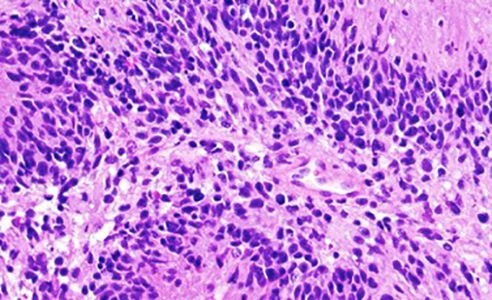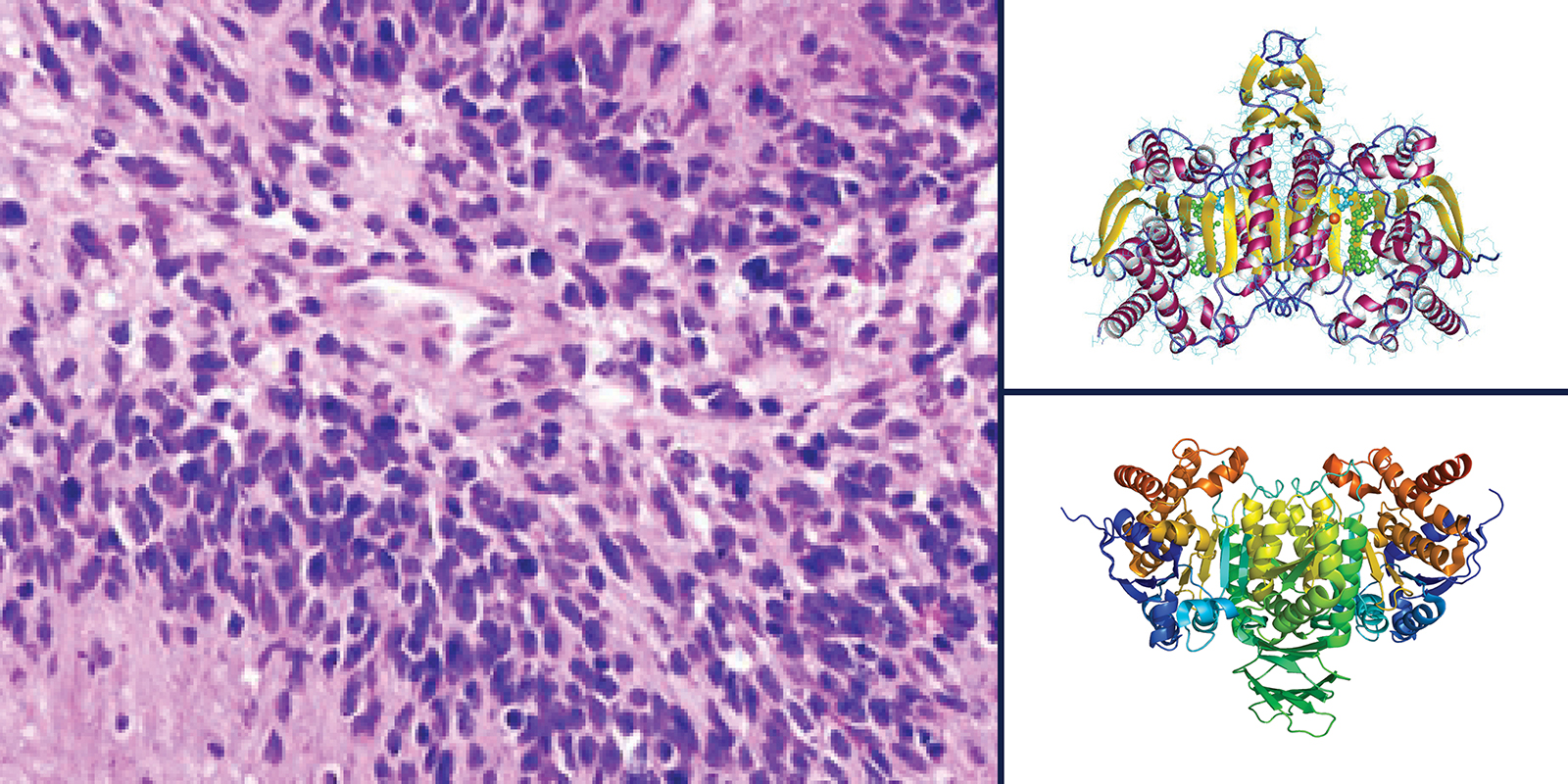
A Decade of Change: Advances in the Classification and Known Causes of Brain Tumors

For many years, the classification of gliomas relied largely on the cells’ general appearance, or histological characteristics, as seen under a microscope. Today, our understanding of glioma subtypes has expanded to include the molecular and genetic variants that can influence a tumor’s development, prognosis, and response to treatment. Until recently, there were few established causes of glioma. Now there are 25 inherited genetic variants known to increase the risk of glioma.
Published today in Nature Reviews Neurology,1Annette Molinaro, PhD, Professor of Neurological Surgery at UCSF, and her colleagues UCSF neuro-oncologist Jennie Taylor, MD, and UCSF professors John Wiencke, PhD, and Margaret Wrensch, PhD, provide a sweeping overview of the many advances that led to the reorganization of the World Health Organization (WHO) classification of adult diffuse gliomas and to our knowledge of their causes. The review also highlights novel ongoing research at UCSF into immunologic factors related to glioma development and prognosis.
Classification of Gliomas
In the United States, an estimated 17,000 adults will be diagnosed this year with diffuse glioma, which includes glioblastoma, astrocytoma, and oligodendroglioma. Among these, high-grade gliomas like glioblastoma have worse prognoses.
“For many years, we observed substantial variation in survival even within classification groups,” said Molinaro. “This was an enormous driving force for the field to find new markers to better characterize glioma subtypes.”
In 2015, two landmark publications, including one from a team of UCSF researchers, found three new tumor markers that reliably classified glioma patients into distinct groups with notable differences in survival, age at diagnosis, among others.2,3

In 2016, the WHO reorganized their classification system for adult diffuse glioma to integrate those molecular features, in addition to others identified since then. The majority of adult diffuse glioma are now classified into the following five groups:
- Glioblastoma, IDH wildtype (no mutation)
- Glioblastoma, IDH mutation
- Diffuse or anaplastic astrocytoma, IDH wildtype (no mutation)
- Diffuse or anaplastic astrocytoma, IDH mutation
- Oligodendroglioma or anaplastic oligodendroglioma, IDH mutation with 1p19q co-deletion

“By better understanding glioma subtypes, we can help our patients make decisions about treatment,” said Taylor.
The Future of Brain Tumor Classification
Since then, additional markers have been identified and are in use today to further improve accuracy in prognoses for certain gliomas. Molinaro and colleagues provide a comprehensive overview of molecular features that are also associated with patient outcome and/or treatment response, including the following:1
- TERT and ATRX mutations affecting telomere maintenance
- Tumor methylation profile
- Methylation of the MGMT promoter
- CDKN2A and/or CDKN2B deletion
- H3 K27M mutation
In the last decade, identifying such molecular features and their associated pathways has provided mechanistic insight into how these distinct tumor subtypes form and their potential response to targeted therapy. For instance, UCSF researchers recently identified a protein subunit that activates mutated TERT promoters,4 which is currently under investigation as a potential therapeutic target.
As we continue to identify additional markers, proposed changes to the WHO guidelines remains an ongoing topic of discussion. Indeed, UCSF neuropathologist Arie Perry, MD is actively involved in cIMPACT-NOW (the Consortium to Inform Molecular and Practical Approaches to CNS Tumor Taxonomy), which was created to assess and recommend regular updates to the brain tumor classification system.5
The discovery of molecular features to better characterize glioma subtypes has certainly impacted the clinic and continues to shape the direction of research. “Increasingly, molecular analysis of patient samples is becoming a more widespread practice. Identifying a patient’s unique tumor profile is critical not only for diagnosis and prediction of prognoses, but potentially for tailoring treatment to the patient’s specific gene alterations,” said Molinaro.
Identifying Glioma Risk Factors
Another recent, significant advance in brain tumor research involves the discovery of 25 inherited variants that increase the risk of glioma.6 The majority of these gene alterations are either in or near genes known to be involved in specific cancer-related pathways, providing additional insight into how gliomas develop.
In contrast, recent observations suggest that a history of allergies (or other conditions with heightened immune responses, like asthma and eczema) is associated with decreased glioma risk.7,8 These findings have spurred additional research, at UCSF and elsewhere, into characteristics of the immune system that are involved in glioma pathogenesis and prognosis.
Large-scale retrospective and prospective epidemiological studies to characterize peripheral immune profiles on the basis of archival DNA are underway at UCSF to assess how variation amongst patients’ immune profiles impacts glioma risk.9
Together, these findings combined with the discoveries of changes within the tumors provide a solid foundation for future research into why some people get glioma and what may be done to help reduce the risk of disease or death from this disease.
References
- Molinaro AM et al. (2019) Genetic and molecular epidemiology of adult diffuse glioma. Nat Rev Neurol. [ePub ahead of print]
- Eckel-Passow JE et al. (2015) Glioma Groups Based on 1p/19q, IDH, and TERT Promoter Mutations in Tumors. N Engl J Med 372(26):2499-508.
- Comprehensive, Integrative Genomic Analysis of Diffuse Lower-Grade Gliomas. (2015) N Engl J Med 372(26):2481-98.
- Mancini A et al. (2018) Disruption of the β1L Isoform of GABP Reverses Glioblastoma Replicative Immortality in a TERT Promoter Mutation-Dependent Manner. Cancer Cell 34(3):513-528.
- Louis DN et al. (2019) cIMPACT-NOW: a practical summary of diagnostic points from Round 1 updates. Brain Pathol. [Epub ahead of print]
- Melin, B. S. et al. (2017) Genome-wide association study of glioma subtypes identifies specific differences in genetic susceptibility to glioblastoma and non-glioblastoma tumors. Nat Genet 49:789-794.
- Amirian ES et al. (2016) Approaching a Scientific Consensus on the Association between Allergies and Glioma Risk: A Report from the Glioma International Case-Control Study. Cancer Epidemiol Biomarkers Prev 25(2):282-90.
- Linos E et al. (2007) Atopy and risk of brain tumors: a meta-analysis. J Natl Cancer Inst 99(20):1544-50.
- Wiencke JK et al. (2017) Immunomethylomic approach to explore the blood neutrophil lymphocyte ratio (NLR) in glioma survival. Clin Epigenet 9:10.
Follow us on Twitter to join the discussion and receive research updates: UCSF Department of Neurological Surgery (@NeurosurgUCSF), Annette Molinaro, PhD (@AnnetteMolinar2), and Jennie Taylor, MD (@JennieWTaylor).